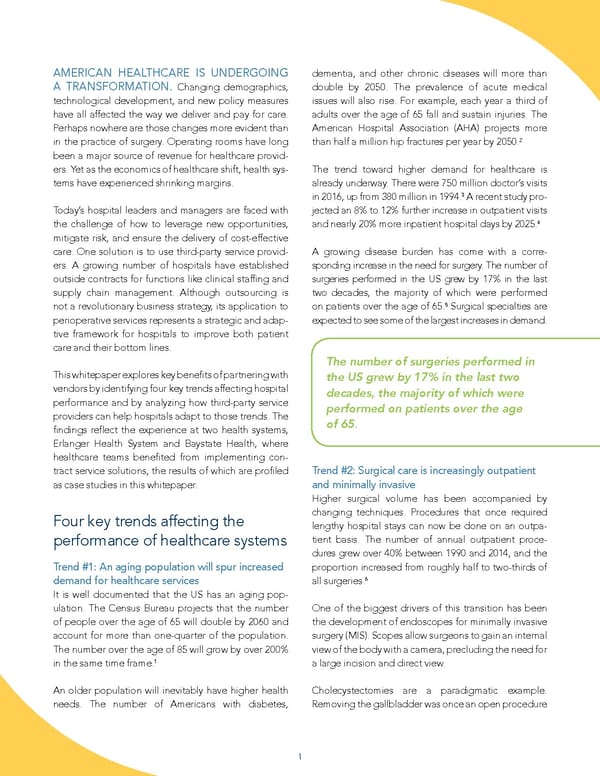AMERICAN HEALTHCARE IS UNDERGOING dementia, and other chronic diseases will more than A TRANSFORMATION. Changing demographics, double by 2050. The prevalence of acute medical technological development, and new policy measures issues will also rise. For example, each year a third of have all affected the way we deliver and pay for care. adults over the age of 65 fall and sustain injuries. The Perhaps nowhere are those changes more evident than American Hospital Association (AHA) projects more 2 in the practice of surgery. Operating rooms have long than half a million hip fractures per year by 2050. been a major source of revenue for healthcare provid- ers. Yet as the economics of healthcare shift, health sys- The trend toward higher demand for healthcare is tems have experienced shrinking margins. already underway. There were 750 million doctor’s visits 3 in 2016, up from 380 million in 1994. A recent study pro- Today’s hospital leaders and managers are faced with jected an 8% to 12% further increase in outpatient visits 4 the challenge of how to leverage new opportunities, and nearly 20% more inpatient hospital days by 2025. mitigate risk, and ensure the delivery of cost-effective care. One solution is to use third-party service provid- A growing disease burden has come with a corre- ers. A growing number of hospitals have established sponding increase in the need for surgery. The number of outside contracts for functions like clinical staffing and surgeries performed in the US grew by 17% in the last supply chain management. Although outsourcing is two decades, the majority of which were performed 5 not a revolutionary business strategy, its application to on patients over the age of 65. Surgical specialties are perioperative services represents a strategic and adap- expected to see some of the largest increases in demand. tive framework for hospitals to improve both patient care and their bottom lines. The number of surgeries performed in This whitepaper explores key benefits of partnering with the US grew by 17% in the last two vendors by identifying four key trends affecting hospital decades, the majority of which were performance and by analyzing how third-party service performed on patients over the age providers can help hospitals adapt to those trends. The of 65. findings reflect the experience at two health systems, Erlanger Health System and Baystate Health, where healthcare teams benefited from implementing con- tract service solutions, the results of which are profiled Trend #2: Surgical care is increasingly outpatient as case studies in this whitepaper. and minimally invasive Higher surgical volume has been accompanied by Four key trends affecting the changing techniques. Procedures that once required lengthy hospital stays can now be done on an outpa- performance of healthcare systems tient basis. The number of annual outpatient proce- dures grew over 40% between 1990 and 2014, and the Trend #1: An aging population will spur increased proportion increased from roughly half to two-thirds of demand for healthcare services all surgeries.6 It is well documented that the US has an aging pop- ulation. The Census Bureau projects that the number One of the biggest drivers of this transition has been of people over the age of 65 will double by 2060 and the development of endoscopes for minimally invasive account for more than one-quarter of the population. surgery (MIS). Scopes allow surgeons to gain an internal The number over the age of 85 will grow by over 200% view of the body with a camera, precluding the need for in the same time frame.1 a large incision and direct view. An older population will inevitably have higher health Cholecystectomies are a paradigmatic example. needs. The number of Americans with diabetes, Remov ing the gallbladder was once an open procedure 1
 Surgical Solutions White Paper Page 2 Page 4
Surgical Solutions White Paper Page 2 Page 4